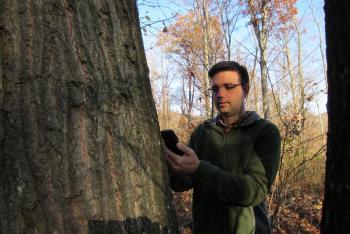New approach can predict impact of climate change on species that can’t get out of the way

Plants and trees are also feeling the change, but they can’t move out of the way. Researchers at the University of Maryland Center for Environmental Science and University of Vermont have developed a new tool to overcome a major challenge of predicting how organisms may respond to climate change.
“When climate changes, organisms have three choices: migrate, adapt, or go extinct,” said lead author Matt Fitzpatrick of the University of Maryland Center for Environmental Science’s Appalachian Laboratory. “We’re bringing the ability to quantify that adaptation piece that had largely been missing up to this point.”
Organisms are adapted to live in certain environments and not others. However climate change is forcing them to live in climates to which they may not be well adapted. Animals can move around, but things like plants and trees are rooted in the ground and must withstand climate change or die.
Scientists have combined genetic analyses with new modeling approaches for the first time to help identify how well balsam popular trees are adapted to handle climate change. The scientists sampled the genetic code of 400 trees from 31 locations across northern North America and combined the genetic variations with computer modeling techniques to map how important genes differ within balsam poplar and to locate where trees may have the best chance of survival in a rapidly warming world.
Up until now, scientists have sought to quantify the risk of climate change to different species by mapping where those species occur today based on climate and then predicting where they may occur in the future. For instance, models for North American tree species often predict them to occur further north as climate warms.
“The problem with the approach is you’re assuming all individuals within a species are identical, like assuming all humans will respond identically to an illness,” said Fitzpatrick. “Some will respond differently given different genetic backgrounds.
It turns out that all members of a species won’t react the same way to climate change. Some poplar trees are already adapted genetically to handle climate changes expected over the next few decades while others are not–just like some people a more likely to survive a disease than others.
Increasingly local adaptation to climate is being studied at the molecular level by identifying which genes control climate adaptation and how these vary between individuals. This type of modeling of variation in genetic makeup represents an important advance in understanding how climate change may impact biodiversity.
“We’ve developed the techniques to associate genetic variation to climate and to map where individuals may and may not be pre-adapted to climates expected in the future,” said Fitzpatrick. “It’s important to know where these places are. This gives us a way to link climate responses more closely to the biology than we were able to do previously.”
The study, “Ecological genomics meets community-level modeling of biodiversity: mapping the genomic landscape of current and future environmental adaptation,” was published by Matthew Fitzpatrick of the University of Maryland Center for Environmental Science and Steven Keller of the University of Vermont. It appeared in the October 1 issue of Ecology Letters.
Media Contact
More Information:
http://www.umces.eduAll latest news from the category: Ecology, The Environment and Conservation
This complex theme deals primarily with interactions between organisms and the environmental factors that impact them, but to a greater extent between individual inanimate environmental factors.
innovations-report offers informative reports and articles on topics such as climate protection, landscape conservation, ecological systems, wildlife and nature parks and ecosystem efficiency and balance.
Newest articles

Nerve cells of blind mice retain their visual function
Nerve cells in the retina were analysed at TU Wien (Vienna) using microelectrodes. They show astonishingly stable behavior – good news for retina implants. The retina is often referred to…

State-wide center for quantum science
Karlsruhe Institute of Technology joins IQST as a new partner. The mission of IQST is to further our understanding of nature and develop innovative technologies based on quantum science by…

Newly designed nanomaterial
…shows promise as antimicrobial agent. Rice scientists develop nanocrystals that kill bacteria under visible light. Newly developed halide perovskite nanocrystals (HPNCs) show potential as antimicrobial agents that are stable, effective…



